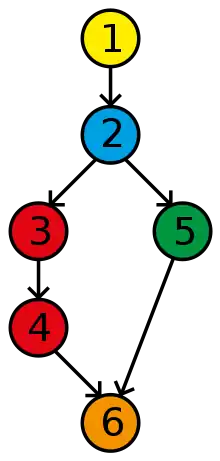Decision-to-decision path
A decision-to-decision path, or DD-path, is a path of execution (usually through a flow graph representing a program, such as a flow chart) between two decisions. More recent versions of the concept also include the decisions themselves in their own DD-paths.

Definition
In Huang's 1975 paper,[1] a decision-to-decision path is defined as path in a program's flowchart such that all the following hold (quoting from the paper):
- its first constituent edge emanates either from an entry node or a decision box;
- its last constituent edge terminates either at a decision box or at an exit node; and
- there are no decision boxes on the path except those at both ends
Jorgensen's more recent textbooks restate it in terms of a program's flow graph (called a "program graph" in that textbook).[2] First define some preliminary notions: chain and a maximal chain. A chain is defined as a path in which:
- initial and terminal nodes are distinct, and
- all interior nodes have in-degree = 1 and out-degree = 1.
A maximal chain is a chain that is not part of a bigger chain.
A DD-path is a set of nodes in a program graph such that one of the following holds (quoting and keeping Jorgensen's numbering, with comments added in parenthesis):[2]
- It consists of a single node with in-degree = 0 (initial node)
- It consists of a single node with out-degree = 0 (terminal node)
- It consists of a single node with in-degree ≥ 2 or out-degree ≥ 2 (decision/merge points)
- It consists of a single node with in-degree = 1 and out-degree = 1
- It is a maximal chain of length ≥ 1.
According to Jorgensen (2013), in Great Britain and ISTQB literature, the same notion is called linear code sequence and jump (LCSAJ).[2]
Properties
From the latter definition (of Jorgensen) we can conclude the following:
- Every node on a flow graph of a program belongs to one DD-path.
- If the first node on a DD-path is traversed, then all other nodes on that path will also be traversed.
- The DD path graph is used to find independent path for testing.
- Every statement in the program has been executed at least once.
DD-path testing
According to Jorgensen's 2013 textbook, DD-path testing is the best known code-based testing method, incorporated in numerous commercial tools.[2]
DD-path testing is also called C2 testing or branch coverage.[3][4]
See also
- Basic block
- Basis path testing and its ancillary articles
- Code coverage
- White-box testing
References
- Huang, J.C. (September 1975). "An Approach to Program Testing". Computing Surveys. 7 (3): 118–119. doi:10.1145/356651.356652. The definition given there is citing: "Fortran automated verification system Level 1 — user's guide, Program Validation Project, General Research Corp., October 1974."
- Paul C. Jorgensen (2013). Software Testing: A Craftsman’s Approach, Fourth Edition. CRC Press. pp. 136–137. ISBN 978-1-4665-6068-0.
- Judith A. Clapp; Saul F. Stanten; W.W. Peng; D.R. Wallace; Deborah A. Cerino; Roger J. Dziegiel Jr. (1995). Software Quality Control, Error, Analysis. William Andrew. pp. 347–348. ISBN 978-1-4377-4484-2.
- J. C. Huang (2009). Software Error Detection through Testing and Analysis. John Wiley & Sons. pp. 164–165. ISBN 978-0-470-46405-2.
